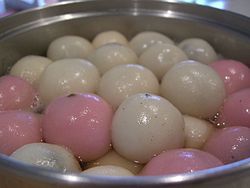Dongzhi Festival
| Dongzhi Festival | |
|---|---|

Tangyuan, a traditional Dongzhi Festival food
|
|
| Official name | Dongzhi (冬至) |
| Also called | Tang-cheh (冬節) Tōji (冬至) Dongji (동지) Đông Chí |
| Observed by | Chinese, Japanese, Koreans, Vietnamese |
| Type | Cultural |
| Significance | Marks the winter solstice |
| Observances | making and eating of tangyuan, ancestor worship |
| Date | Winter solstice (between December 21 and December 23) |
| 2016 date | December 21 |
| 2017 date | December 22 |
| 2018 date | December 22 |
| 2019 date | December 22 |
| Frequency | annual |
| Related to | Winter solstice |
| Dongzhi Festival | |||||||||||||||||||||||||
| Chinese name | |||||||||||||||||||||||||
|---|---|---|---|---|---|---|---|---|---|---|---|---|---|---|---|---|---|---|---|---|---|---|---|---|---|
| Chinese | 冬至 | ||||||||||||||||||||||||
|
|||||||||||||||||||||||||
| Alternative Chinese name | |||||||||||||||||||||||||
| Chinese | 冬節 | ||||||||||||||||||||||||
|
|||||||||||||||||||||||||
| Vietnamese name | |||||||||||||||||||||||||
| Vietnamese alphabet | Đông chí | ||||||||||||||||||||||||
| Korean name | |||||||||||||||||||||||||
| Hangul | 동지 | ||||||||||||||||||||||||
| Hanja | 冬至 | ||||||||||||||||||||||||
|
|||||||||||||||||||||||||
| Japanese name | |||||||||||||||||||||||||
| Kanji | 冬至 | ||||||||||||||||||||||||
| Hiragana | とうじ | ||||||||||||||||||||||||
|
|||||||||||||||||||||||||
| Transcriptions | |
|---|---|
| Standard Mandarin | |
| Hanyu Pinyin | Dōngzhì |
| Bopomofo | ㄉㄨㄥ ㄓˋ |
| Wu | |
| Romanization | Ton平 tsy去 |
| Yue: Cantonese | |
| Jyutping | dung1 zi3 |
| Southern Min | |
| Hokkien POJ | Tang-chì |
| Eastern Min | |
| Fuzhou BUC | Dĕ̤ng-cé |
| Transcriptions | |
|---|---|
| Southern Min | |
| Hokkien POJ | Tang-cheh or Tang-choeh |
| Eastern Min | |
| Fuzhou BUC | Dĕ̤ng-cáik |
| Transcriptions | |
|---|---|
| Revised Romanization | Dongji |
| Transcriptions | |
|---|---|
| Revised Hepburn | Tōji |
The Dōngzhì Festival or Winter Solstice Festival (Chinese: 冬至; pinyin: Dōngzhì; literally: "the arrival of winter") is one of the most important festivals celebrated by the Chinese and other East Asians during the Dongzhi solar term (winter solstice) on or around December 22 (according to East Asia time).
The origins of this festival can be traced back to the yin and yang philosophy of balance and harmony in the cosmos. After this celebration, there will be days with longer daylight hours and therefore an increase in positive energy flowing in. The philosophical significance of this is symbolized by the I Ching hexagram fù (復, "Returning").
Traditionally, the Dongzhi Festival is also a time for the family to get together. One activity that occurs during these get-togethers (especially in the southern parts of China and in Chinese communities overseas) is the making and eating of tangyuan (湯圓) or balls of glutinous rice, which symbolize reunion.Tangyuan are made of glutinous rice flour and sometimes brightly coloured. Each family member receives at least one large tangyuan in addition to several small ones. The flour balls may be plain or stuffed. They are cooked in a sweet soup or savory broth with both the ball and the soup/broth served in one bowl. It is also often served with a mildly alcoholic unfiltered rice wine containing whole grains of glutinous rice (and often also Sweet Osmanthus flowers), called jiuniang.
In northern China, people typically eat dumplings on Dongzhi. It is said to have originated from Zhang Zhongjing in the Han Dynasty. On one cold winter day, he saw the poor suffering from chilblains on their ears. Feeling sympathetic, he ordered his apprentices to make dumplings with lamb and other ingredients, and distribute them among the poor to keep them warm, to keep their ears from getting chilblains. Since the dumplings were shaped like ears, Zhang named the dish "qùhán jiāoěr tāng" (祛寒嬌耳湯) or dumpling soup that expels the cold. From that time on, it has been a tradition to eat dumplings on the day of Dongzhi.
...
Wikipedia
